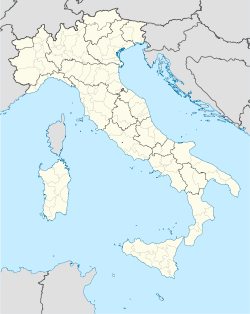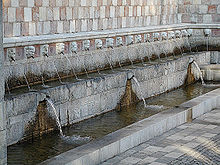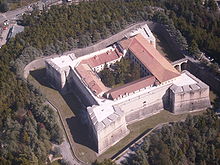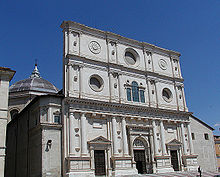- L'Aquila
-
L'Aquila — Comune — Comune dell'Aquila Piazza Duomo 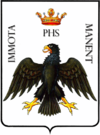
Coat of armsLocation of L'Aquila in Italy Coordinates: 42°21′N 13°24′E / 42.35°N 13.4°ECoordinates: 42°21′N 13°24′E / 42.35°N 13.4°E Country Italy Region Abruzzo Province L'Aquila (AQ) Frazioni see list Government – Mayor Massimo Cialente (Democratic Party) Area – Total 466.9 km2 (180.3 sq mi) Elevation 714 m (2,343 ft) Population (31 March 2009) – Total 73,150 – Density 156.7/km2 (405.8/sq mi) Demonym Aquilani Time zone CET (UTC+1) – Summer (DST) CEST (UTC+2) Postal code 67100 Dialing code 0862 Patron saint St. Maximus, St. Equitius, St. Peter Celestine, St. Bernardino of Siena Saint day June 10 Website Official website L'Aquila (Italian: [ˈlaːkwila] (
 listen), meaning "The Eagle") is a city and comune in central Italy, both the capital city of the Abruzzo region and of the Province of L'Aquila. As of 2009[update], it has a population of 73,150 inhabitants, but has a daily presence in the territory of 100,000 people for study, tertiary activities, jobs and tourism. Laid out within medieval walls on a hill in the wide valley of the Aterno river, it is surrounded by the Apennine Mountains, with the Gran Sasso d'Italia to the north-east.
listen), meaning "The Eagle") is a city and comune in central Italy, both the capital city of the Abruzzo region and of the Province of L'Aquila. As of 2009[update], it has a population of 73,150 inhabitants, but has a daily presence in the territory of 100,000 people for study, tertiary activities, jobs and tourism. Laid out within medieval walls on a hill in the wide valley of the Aterno river, it is surrounded by the Apennine Mountains, with the Gran Sasso d'Italia to the north-east.L'Aquila sits upon a hillside in the middle of a narrow valley; tall snow-capped mountains of the Gran Sasso massif flank the town. A maze of narrow streets, lined with Baroque and Renaissance buildings and churches, open onto elegant piazzas. Home to the University of L'Aquila, it is a lively college town and, as such, has many cultural institutions: a repertory theater, a symphony orchestra, a fine-arts academy, a state conservatory,a film institute.The city presents a tradition in the winter sports with 4 ski resorts which lies around the city.
Contents
Geography
Close to the highest of the Apennine summits, L’Aquila is positioned at an altitude of 721 meters in the Valley of the Aterno-Pescara, wedged between no fewer than four mountain peaks above 2,000 meters.
The mountains block the city off from warm humid air currents from the Mediterranean, and give rise to a climate that is cool in comparison to most of central Italy, and dry. It has been said that the city enjoys each year eleven cold months and one cool one.
L’Aquila is approximately 100 kilometers (62 mi) to the east-north-east of Rome, with which it is now connected by an autostrada through the mountains.
History
The city's construction was begun by Frederick II, Holy Roman Emperor and King of Sicily out of several already existing villages (ninety-nine, according to local tradition; see Amiternum), as a bulwark against the power of the papacy. The name of Aquila means "Eagle" in Italian. Construction was completed in 1254 under Frederick's son, Conrad IV of Germany. The name was switched to Aquila degli Abruzzi in 1861, and L'Aquila in 1939. After the death of Conrad, the city was destroyed by his brother Manfred in 1259, but soon rebuilt by Charles I of Anjou, its successor as king of Sicily. The walls were completed in 1316.
It quickly became the second city of the Kingdom of Naples. It was an autonomous city, ruled by a diarchy composed of the City Council (which had varying names and composition over the centuries) and the King's Captain. It fell initially under the lordship of Niccolò dell'Isola, appointed by the people as the People's Knight, but he was then killed when he became a tyrant. Later, it fell under Pietro "Lalle" Camponeschi, Count of Montorio, who became the third side of a new triarchy, with the Council and the King's Captain. Camponeschi, who was also Great Chancellor of the kingdom of Naples, became too powerful, and was killed by order of Prince Louis of Taranto. His descendants fought with the Pretatti family for power for several generations, but never again attained the power of their ancestor. The last, and the one true "lord" of L'Aquila, was Ludovico Franchi, who challenged the power of the pope by giving refuge to Alfonso I d'Este, former duke of Ferrara, and the children of Giampaolo Baglioni, deposed lord of Perugia. In the end, however, the Aquilans had him deposed and imprisoned by the king of Naples.
The power of L'Aquila was based on the close connection between the city and its mother-villages, which had established the city as a federation, each of them building a borough and considering it as a part of the mother-village. That is also why number 99 is so important in the architecture of L'Aquila, and a very peculiar monument, the Fountain of the 99 Spouts (Fontana delle 99 Cannelle), was given its name to celebrate the ancient origin of the town. The City Council was originally composed of the Mayors of the villages, and the city had no legal existence until King Charles II of Naples appointed a "Camerlengo", responsible for city tributes (previously paid separately by each of its mother-villages). Later, the Camerlengo also took political power, as President of the City Council.
From its beginnings the city constituted an important market for the surrounding countryside, which provided it with a regular supply of food: from the fertile valleys came the precious saffron; the surrounding mountain pastures provided summer grazing for numerous transhumant flocks of sheep, which in turn supplied abundant raw materials for export and, to a lesser extent, small local industries, which in time brought craftsmen and merchants from outside the area.
Within a few decades L'Aquila became a crossroads in communications between cities within and beyond the Kingdom, thanks to the so-called "via degli Abruzzi", which ran from Florence to Naples by way of Perugia, Rieti, L'Aquila, Sulmona, Isernia, Venafro, Teano and Capua.
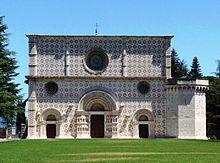 Church of Santa Maria di Collemaggio.
Church of Santa Maria di Collemaggio.
Negotiations for the succession of Edmund, son of Henry III of England, to the throne of the Kingdom of Sicily involved L'Aquila in the web of interests linking the Papal Curia to the English court. On 23 December 1256, Pope Alexander IV elevated the churches of Saints Massimo and Giorgio to the status of cathedrals as a reward to the citizens of L'Aquila for their opposition to King Manfred who, in July 1259, had the city razed to the ground in an attempt to destroy the negotiations. On August 29, 1294, the hermit Pietro del Morrone was consecrated as pope Celestine V in the church of Santa Maria di Collemaggio, in commemoration of which the new pope decreed the annual religious rite of the Pardon (Perdonanza Celestiniana), still observed today in the city on August 28 and 29: it is the immediate ancestor of the Jubilee Year.
The pontificate of Celestine V gave a new impulse to building development, as can be seen from the city statutes. In 1311, moreover, King Robert of Anjou granted privileges which had a decisive influence on the development of trade. These privileges protected all activities related to sheep-farming, exempting them from customs duties on imports and exports. This was the period in which merchants from Tuscany (Scale, Bonaccorsi) and Rieti purchased houses in the city. Hence the conditions for radical political renewal: in 1355 the trade guilds of leather-workers, metal-workers, merchants and learned men were brought into the government of the city, and these together with the Camerario and the Cinque constituted the new Camera Aquilana. Eleven years earlier, in 1344, the King had granted the city its own mint.
In the middle of the 14th century the city was struck by plague epidemics (1348, 1363) and earthquakes (1349). Reconstruction began soon, however. In the 14th-15th century Jewish families came to live in the city, while the generals of the Franciscan Order chose the city as the seat of the Order's general chapters (1376, 1408, 1411, 1450, 1452, 1495). Bernardino of Siena, of the Franciscan order of the Observance, visited L'Aquila twice, the first time to preach in the presence of King René of Naples, and in 1444, on his second visit, he died in the city. In 1481 Adam of Rottweil, a pupil and collaborator of Johann Gutenberg, obtained permission to establish a printing press in L'Aquila.
The Osservanti branch of the Franciscan order had a decisive influence on L'Aquila. As a result of initiatives by Friar Giovanni da Capistrano and Friar Giacomo della Marca, Lombard masters undertook, in the relatively underdeveloped north-east of the city, an imposing series of buildings centring on the hospital of Saint Salvatore (1446) and the convent and the basilica of Saint Bernardino. The construction work was long and difficult, mainly because of the earthquake of 1461, which caused the buildings to collapse, and the translation of the body of S. Bernardino did not take place until May 14, 1472. The whole city suffered serious damage on the occasion of the earthquake, and two years went by before repairs on the churches and convents began.
In a strategy finalized to increasing their political and economic autonomy, the Aquilani took a series of political gambles, siding sometimes with the Roman Papacy, sometimes with the Kingdom of Naples. When the Pope excommunicated Joanna II, Queen of Naples, appointing Louis III of Anjou as heir to the crown in her stead, L'Aquila sided with the Angevines. Joanna called to fight for her Braccio da Montone, lord of Perugia, Todi, Assisi, Spello and Jesi, one of the greatest Italian condottieri of the time. In exchange for his services, Braccio obtained the lordship of Teramo, as well as the fiefdoms of Capua and Foggia, and he started a 13-year-long siege of L'Aquila, that resisted bravely. Facing Braccio at the head of the Angevine army was Muzio Attendolo Sforza and his son Francesco. The final clash between the two contenders was just below the walls of Aquila, near the hamlet today called Bazzano. On 2 June 1424 the battle was fought between the most celebrated condottieri of the time; Braccio, mortally wounded in the neck, was made prisoner and transported to Aquila, where he died three days later, on June 5, 1424. The Pope had him buried in deconsecrated earth. The citizens of L'Aquila honoured the bravery of their enemy Braccio by dedicating one of the main streets of the city to his name.
This period of freedom and prosperity ended in the 16th century, when Spanish viceroy Philibert van Oranje partially destroyed L'Aquila and established Spanish feudalism in its countryside. The city, separated from its roots, never developed again. Ancient privileges were revoked. L'Aquila was again destroyed by an earthquake in 1703. Successive earthquakes have repeatedly damaged the city's large Duomo, and destroyed the original dome of the basilica of San Bernardino, designed along the lines of the dome of Santa Maria del Fiore in Florence.
The city was also sacked two times by French troops in 1799.
L'Aquila, like so much of Italy, is a city of political contrasts. In the 1970s a novel by Alberto Moravia was seized because considered obscene and a local Catholic Archbishop protested the nudity of a centuries-old statue of a young man, and a group of local reactionaries even asked for the seizure of the £50 coin, because it showed a naked man. However, in October 2003 a liberal judge in l'Aquila ordered the small town of Ofena to remove a crucifix from its elementary school so as to not to offend the religious sensibilities of two young Muslim students. After a national outcry, the judge's decision was overturned. In May 2007 Massimo Cialente, a physician and medical researcher, was elected mayor of L'Aquila with a center-left coalition.
Earthquakes
See also: 2009 L'Aquila earthquake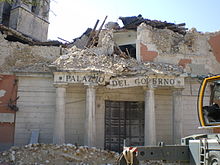 The local prefecture (a government office) damaged by the earthquake.
The local prefecture (a government office) damaged by the earthquake.
Earthquakes mark the history of L'Aquila, as the city is situated partially on an ancient lake-bed that amplifies seismic activity.[1][2]
On December 3, 1315, the city was struck by an earthquake which seriously damaged the San Francesco Church. Another earthquake struck on January 22, 1349, killing about 800 people. Other earthquakes struck in 1452, then on November 26, 1461, and again in 1501 and 1646. On February 3, 1703 a major earthquake struck the town. More than 3.000 people died and almost all the churches collapsed; Rocca Calascio, the highest fortress in Europe was also ruined by this event, yet the town survived. L'Aquila was then repopulated by decision of Pope Clement XI. The town was rocked by earthquake again in 1706. The most serious earthquake in the history of the town struck on July 31, 1786, when more than 6.000 people died. On June 26, 1958 an earthquake of 5.0 magnitude struck the town.
On April 6, 2009, at 01:32 GMT (03:32 CEST) an earthquake of 6.3 magnitude struck central Italy with its epicentre near L'Aquila, at 42°25′22″N 13°23′40″E / 42.4228°N 13.3945°E.[3] The earthquake caused damage to between 3,000 and 11,000 buildings in the medieval city of L'Aquila.[4] Several buildings also collapsed. 308 people were killed by the earthquake, and approximately 1,500 people were injured. Twenty of the victims were children.[5] Around 65,000 people were made homeless.[6] There were many students trapped in a partially collapsed dormitory.[7] The April 6 earthquake was felt throughout Abruzzo; as far away as Rome, other parts of Lazio, Marche, Molise, Umbria, and Campania.
G8 summit
See also: 35th G8 summitBecause of the 2009 earthquake, the Berlusconi government decided to move that year's G8 summit from its scheduled Sardinian host of La Maddalena to L'Aquila, so that disaster funds would be distributed to the affected region and to show solidarity with the city's inhabitants.[8] World leaders converged on L'Aquila on July 8 and many of them were given tours of the devastated city by the host Prime Minister.[9] A Washington Post newspaper article on April 11, 2010, reported that in February 2010, residents of L'Aquila, frustrated that cleanup efforts of the destroyed downtown had not begun after ten months of waiting, had organized daily volunteer crews to haul away rubble themselves. Many of these displaced residents have been re-housed in new housing on the fringe of town, and missed the vibrant life, shops and cafes downtown that were damaged and shuttered (reportedly some 2,000 businesses have closed).
Climate
Climate data for Stazione Meteo L'Aquila 42°22′N 13°21′E / 42.367°N 13.35°E Month Jan Feb Mar Apr May Jun Jul Aug Sep Oct Nov Dec Year Average high °C (°F) 6.4
(43.5)8.5
(47.3)12.3
(54.1)16.3
(61.3)20.9
(69.6)25.3
(77.5)29.0
(84.2)29.1
(84.4)24.7
(76.5)18.4
(65.1)12.2
(54.0)7.4
(45.3)17.54
(63.58)Daily mean °C (°F) 2.3
(36.1)3.8
(38.8)7.0
(44.6)10.7
(51.3)14.9
(58.8)18.7
(65.7)21.6
(70.9)21.6
(70.9)18.1
(64.6)12.8
(55.0)7.8
(46.0)3.7
(38.7)11.92
(53.45)Average low °C (°F) −1.8
(28.8)−1
(30.2)1.7
(35.1)5.0
(41.0)8.8
(47.8)12.2
(54.0)14.2
(57.6)14.1
(57.4)11.4
(52.5)7.2
(45.0)3.3
(37.9)−0.1
(31.8)6.25
(43.25)Rainfall mm (inches) 66.1
(2.602)64.5
(2.539)51.2
(2.016)56.6
(2.228)51.0
(2.008)46.1
(1.815)34.7
(1.366)37.7
(1.484)52.8
(2.079)66.3
(2.61)91.3
(3.594)83.7
(3.295)702
(27.64)Snowfall cm (inches) 27
(10.6)19.8
(7.8)7.2
(2.83)0
(0)0
(0)0
(0)0
(0)0
(0)0
(0)0
(0)0
(0)13.8
(5.43)67.8
(26.7)Avg. rainy days 8 8 8 9 8 6 5 5 6 8 10 10 91 Avg. snowy days 3 2.2 1 0 0 0 0 0 0 0 0 1.6 7.8 Source: [10] Main sights
Although less than an hour-and-a-half drive from Rome, and a popular summer and winter resort with Romans hiking and skiing in the surrounding mountains, the city has not yet been heavily affected by foreign tourism.
In the highest part of the town is the massive Spanish fort (Forte Spagnolo), erected by the Spanish viceroy Don Pedro de Toledo in 1534. It is currently home to the National Museum of Abruzzo.
The Cathedral of San Massimo (Duomo) was built in the 13th century, but crumbled down during the 1703 earthquake. The most recent façade is from the 19th century, but after the earthquake of 2009 and subsequent aftershocks the transept and possibly more of the Cathedral has collapsed.
The church of Saint Bernardino of Siena (1472) has a fine Renaissance façade by Nicolò Filotesio (commonly called Cola dell'Amatrice), and contains the monumental tomb of the saint, decorated with beautiful sculptures, and executed by Silvestro Ariscola in 1480.
The church of Santa Maria di Collemaggio, just outside the town, has a very fine Romanesque façade of simple design (1270–1280) in red and white marble, with three finely decorated portals and a rose-window above each. The two side doors are also fine. The interior contains the mausoleum of Pope Celestine V erected in 1517. Many smaller churches in the town have similar façades (S. Giusta, S. Silvestro and others).
The town also contains some fine palaces: the municipality has a museum, with a collection of Roman inscriptions and some illuminated service books. The Palazzi Dragonetti and Persichetti contain private collections of pictures. Outside the town is the Fontana delle novantanove cannelle, a fountain with ninety-nine jets distributed along three walls, constructed in 1272. The source of the fountain is still unknown.
A well-known city landmark is the Fontana Luminosa ("Luminous Fountain"), a sculpture of two women bearing large jars, built in the 1930s. The local cemetery includes the grave of Karl Heinrich Ulrichs, a 19th‑century German gay rights pioneer, who lived and died at L'Aquila: every year, gay people from all over the world meet at the cemetery to honour his memory.
The surrounding area boasts Roman ruins (the important Roman city of Amiternum), ancient monasteries, and numerous castles. The best-known of these is Rocca Calascio (used in the 1980s as the location for the movie Ladyhawke), which is the highest castle in Italy and one of the highest in Europe. Also nearby are several ski resorts like Gran Sasso d'Italia, the highest of the Apennines where in its valley the movie The Name of the Rose was filmed in the end of the 1980s.
Culture
Cinematographic activities
The first step of L'Aquila in the cinematographic activities was the Cineforum Primo Piano founded by Gabriele Lucci in the middle of 1970s. As a work of Lucci, in 1981 saw the establishment of l'Istituto Cinematografico dell'Aquila, an institute for the production and diffusion of the cinematographic culture in Italia and abroad.
The Teatro Stabile d'Abruzzo is based in the city and was formed in 2000.
Sport
The city is the home of five-time Italian champions L'Aquila Rugby. The football squad, L'Aquila Calcio, played 3 times in serie B.
Frazioni
There are some frazioni, villages around principal towns, surrounding L'Aquila. The following is a list of surrounding frazioni: Aquilio, Aragno, Aringo, Arischia, Assergi, Bagno, Bazzano, Camarda, Cansatessa, Casaline, Cermone, Cese, Civita di Bagno, Colle di Preturo, Colle di Sassa, Colle Roio - Poggio di Roio, Collebrincioni, Collefracido, Coppito, Filetto, Foce, Forcelle, Genzano, Gignano, Monticchio, Onna, Paganica, Pagliare di Sassa, Pescomaggiore, Palombaia, Pettino, Pianola, Pile, Pizzutillo, Poggio Roio, Poggio Santa Maria, Pozza di Preturo, Pratelle, Preturo, Ripa, Roio Piano - Poggio di Roio, San Giacomo alto, San Giuliano, San Gregorio, San Leonardo, San Marco Di Preturo, San Martino di Sassa, Santa Rufina, Sant'Angelo, Sant'Elia, Santi, San Vittorino, Sassa, Tempera, Torretta, Valle Pretara, Vallesindola, Vasche.
International relations
See also: List of twin towns and sister cities in ItalyTwin towns — Sister cities
L'Aquila is twinned with:
Notable residents
- Mariangelo Accursio, (Aquila, 1489 - Aquila, 1546), Humanist
- Amico Agnifili, (Rocca di Mezzo, 1398 - Aquila, 1476), Cardinal
- Anton Ludovico Antinori, (Aquila, 1704 - Aquila, 1778), historian
- Corrado Bafile (1903–2005), Cardinal
- Giulio Cesare Benedetti Guelfaglione, (Aquila, ? - Rome, 1656), Physician
- Bernardino da Siena, (Massa Marittima, 1380 – Aquila, 1444), saint.
- Braccio da Montone, (Perugia, 1368 - Aquila, 1424), condottiero
- Giovanbattista Branconio dell'Aquila, (Aquila, 1473 - 1522), papal protonotary, friend of Raphael
- Buccio di Ranallo, (Aquila 1294 - Aquila 1363), epic poet.
- Raffaele Cappelli (1848–1921)
- John of Capistrano, (Capestrano, 1386 - Ilok, 1456), saint
- Cesare Campana, (Aquila, 1532 - Vicenza, 1606), Historian and Poet
- Celestine V, (?, 1215 - Fumone, 1296), saint
- Pompeo Cesura, (Aquila, ? - Rome, 1571), painter
- Filipe Lorenzo Cianfarani (Phil Farren) 1874-1952, bandmaster Indiana
- Appius Claudius Caecus, (Amiternum, 350 a.C. - ?, 271 a.C.), Roman Politician
- Nazzareno De Angelis (1881–1962), opera singer
- Serafino De' Ciminelli, (Aquila, 1466 - Rome, 1500), poet
- Carlo Franchi (1698–1769), racing driver
- Mario Magnotta (1942–2009), janitor and internet phenomena
- Lorenzo Natali, (Florence,1922 – Rome,1989), vice-president of the European Commission.
- Paul Piccone (1940–2004), founder and editor of TELOS.
- Cesare Rivera, (Aquila, 1539 - Napoli, 1602), humanist
- Roberto Ruscitti (b. 1941), composer
- Sallustius (4th century), historian
- Karl Heinrich Ulrichs (1825–1895), writer
- Trebisonda Valla, (Bologna 1916 – L'Aquila 2006), Olympic gold medal
- Amleto Vespa (1888–1940), spy for Japan
- Bruno Vespa (b. 1944), journalist
See also
References
- Poland, Chris, Holly Razzano, Andrew Scott, and Ricardo Hernandez. "L'Aquila, Italy: The Next Lesson." Civil Engineering (08857024), 79.11 (2009): 46-53.
Bibliography
- Bindi (1889). Monumenti storici ed artistici degli Abruzzi. Naples. p. 771 seq..
 This article incorporates text from a publication now in the public domain: Chisholm, Hugh, ed (1911). Encyclopædia Britannica (11th ed.). Cambridge University Press.
This article incorporates text from a publication now in the public domain: Chisholm, Hugh, ed (1911). Encyclopædia Britannica (11th ed.). Cambridge University Press.
Notes
- This article incorporates information from the equivalent article in the French Wikipedia, consulted during April 2009.
- ^ "L'Aquila, prov. of L'Aquila, Abruzzo". Abruzzo2000.com. http://www.abruzzo2000.com/abruzzo/laquila/laquila.htm. Retrieved 2009-04-06.
- ^ Earth-prints.org
- ^ USGS.gov
- ^ "Powerful Italian quake kills many". BBC News Online (London). 6 April 2009. http://news.bbc.co.uk/2/hi/europe/7984867.stm.
- ^ "TG1 ed. 08.00 08.04 integrale" (in Italian). TG1. 8 April 2009. Archived from the original on 29 July 2009. http://www.webcitation.org/5iceiNi41. Retrieved 9 April 2009.
- ^ Hooper, John (28 April 2009). "Pope visits Italian village hit hardest by earthquake". The Guardian (London). http://www.guardian.co.uk/world/2009/apr/28/pope-visits-earthquake-zone.
- ^ RAI One news. Live reports from L'Aquila, retrieved 6 April 2009, =9:26 CET
- ^ "G8: Italy Wants to Move Summit to L'Aquila"
- ^ "Obama inspects quake damage in L’Aquila". EuroNews. 2009-07-09. http://www.euronews.net/2009/07/09/obama-inspects-quake-damage-in-l-aquila/. Retrieved 2009-07-09.
- ^ "Il clima dell'Aquila". CETEMPS. http://cetemps.aquila.infn.it/tempaq/MR/articoliMR/climalaquila.html. Retrieved September 26, 2011.
- ^ "Hobart Offers Condolences to Italian Sister City L’Aquila Severely Damaged by Earthquake". Hobart City Council. 07-04-2009. http://www.hobartcity.com.au/hccwr/_assets/main/lib60034/l%27aquila%20earthquake-hcc%20media%20release%20_2_.pdf. Retrieved 2009-06-27.
- ^ "Zielona Góra - Partner Cities". Urzędu Miasta Zielona Góra.. http://www.zielona-gora.pl/umzg/index.php?id=1111&lng=pl. Retrieved 2008-12-07.[dead link]
External links
- Official website (Italian)
- Gran Sasso Images, news (Italian)
- In the Land of Bears and Castles, The Financial Times, June 29, 2007
Regional capitals of Italy L'Aquila, Abruzzo
Aosta, Aosta Valley
Bari, Apulia
Potenza, BasilicataCategories:- Cities and towns in Abruzzo
- Communes of the Province of L'Aquila
- L'Aquila
Wikimedia Foundation. 2010.


